When Gov. Mike Parson’s plane touched down in Springfield last Tuesday to help kickoff the World’s Fishing Fair at Bass Pro Shops, the plane did not go to the same state-of-the-art terminal where passengers typically board flights to destinations like Denver, Orlando or Dallas.
Instead, it taxied to the opposite side of the airport property, where a small building with a concrete and glass exterior stands among several hangars. Three Missouri State Highway Patrol Officers, clad in business suits as part of their security detail assignments, met the governor on the apron and whisked Parson quickly through the general aviation terminal to a waiting vehicle.
Summary
The general aviation terminal at the Springfield-Branson National Airport (SGF) is set to undergo about $5.9 million in expansion and renovation by the end of 2023. The terminal serves private flights and charter jets, and is an economic driver for the airport and for the Springfield community.
The general aviation terminal is a part of the airport that many people don’t see. If you have a ticket and are headed to Las Vegas, Chicago or Atlanta, you will board your plane at the commercial terminal that sits on the west side of SGF’s two runways.
On the east side, the general aviation terminal is the home of the fixed base operation (FBO) for the Springfield-Branson National Airport. It’s where people go to board private flights or chartered planes.
On the Tuesday before the World’s Fishing Fair, the terminal staff expected about 15 private flights with VIPs in about two hours.
Long term, Springfield-Branson Airport Director of Aviation Brian Weiler expects an upgraded general aviation terminal to turn into a steady revenue generator for the airport. The upgrades will be done using a different model of bidding and contracting than most government projects use. The total project budget, according to the preliminary designer, should be about $5.9 million.
“We’re not going to ask the city for any money on this — totally ours,” Weiler said.
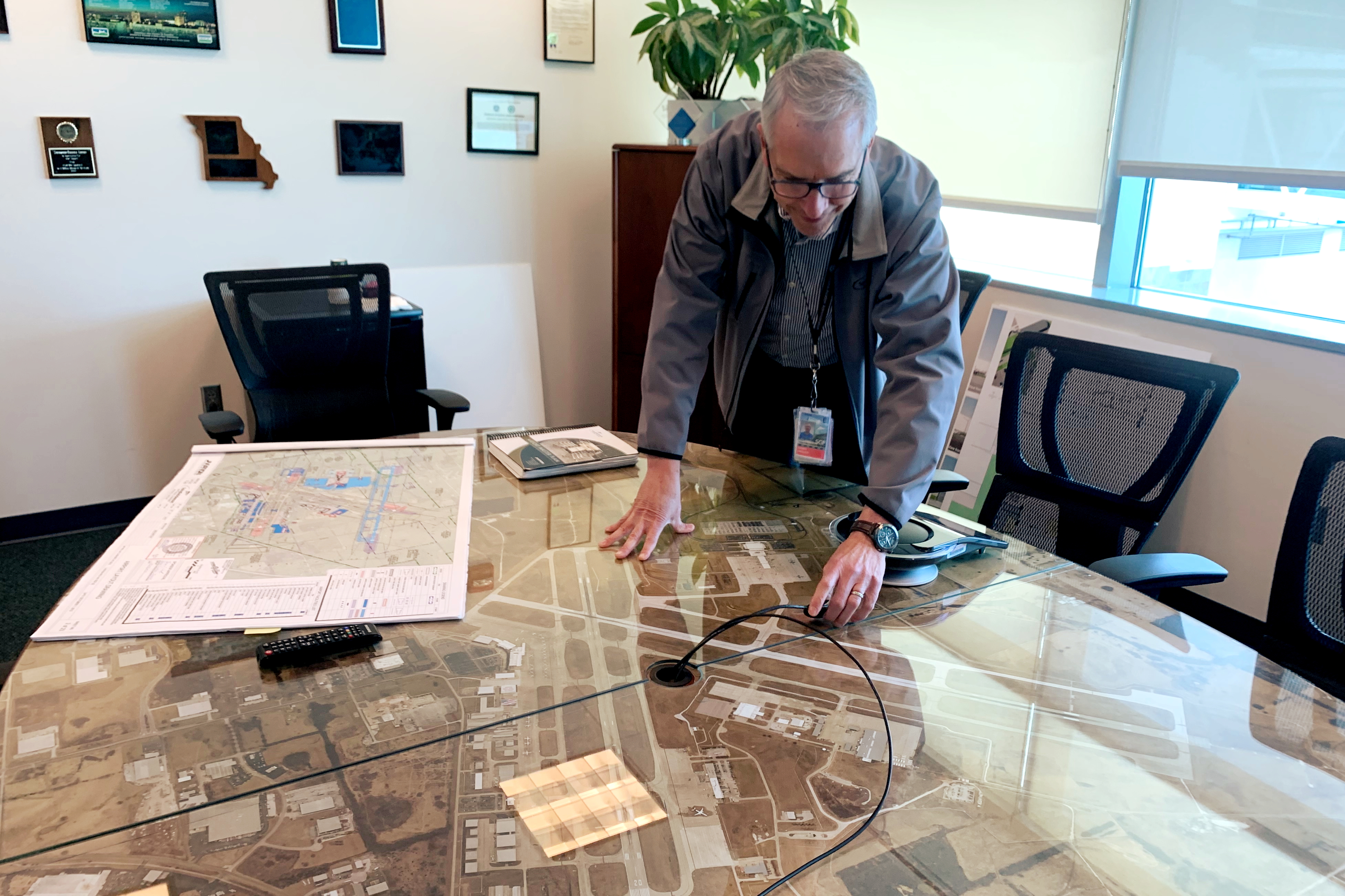
(Photo by Rance Burger)
The general aviation terminal got a facelift worth about $250,000 in 2011. The general aviation terminal serves different clients than the airport’s commercial terminal.
“That’s equally as important, it’s just a different clientele. It’s the business leaders, it’s politicians, VIPs, training. Those people fly in there, so the general aviation terminal is, in my mind, equally as important,” Weiler said. “Ours is okay.”
A plan that the Springfield City Council will consider in April offers the Springfield Airport Board the clearance to use a method of hiring a contractor that differs from traditional practices. Weiler said there is no financial risk to taxpayers. The airport generates revenue through a variety of means — fuel sales, parking, airfare and hangar leases, among the many. By law, revenue generated at the airport must be put back in the airport, preventing the city of Springfield from using its airport revenue to subsidize projects in other places.
“One thing that a lot of people don’t really understand is, yes, we’re part of the city, but we receive zero tax dollars,” Weiler said. “As an enterprise fund, we’re run like a business.”
A crowded, aging building
The general aviation terminal in Springfield was built in 1990. On March 29, three pilots were on laptops or tablets in the pilots lounge room of the terminal, waiting to depart later in the day. The lounge is scarcely the size of a bedroom. Down the hall, a room for pilots to file flight plans or examine courses sits empty, rendered obsolete by technological advancement. Weiler said most pilots file flight plans from their own devices, or from devices provided by their employers.
Weiler said the building isn’t bad, but it is small and inefficient in places.
“I would say it’s served us well for the last 30 years, but I think we’re all recognizing that our general aviation area continues to grow like all parts of the airport, and so we’re trying to make sure that that facility serves us for the next 30 years, and it’s lacking in some areas,” Weiler said.
Why care?
While commercial flights at Springfield-Branson National are at about 90 percent of the passenger traffic experienced before the COVID-19 pandemic, private flights and charter planes are still in operation for a variety of reasons. Most recently, the general aviation terminal was a hub of activity for VIPs coming into Springfield for the World’s Fishing Fair at Bass Pro Shops. Fuel sold through the fixed base operation is one of the key revenue generators for the airport.
In November 2020, the Springfield Airport Board started the process of planning to improve the general aviation terminal. After what Weiler said was a nationwide search, it chose Springfield-based architecture firm Dake Wells to do the preliminary design. Dake Wells has done design work for the renovation and additions to Glass Hall at Missouri State University, the Schweitzer Brentwood Branch Library in Springfield and the home offices for Andy's Frozen Custard, among other major projects in the public and private sectors.
The initial design for the FBO expansion cost approximately $124,000 to produce. The architects designed construction schematics in order to prepare the project for competitive bidding. Some of the design work was funded by the airport board selling off property in Christian County.
“FAA has approved us to use approximately the last $200,000 that we had from the proceeds of the Air Park South property, which is down in Ozark,” Weiler said. “We already used up some of that with the schematic stuff.”
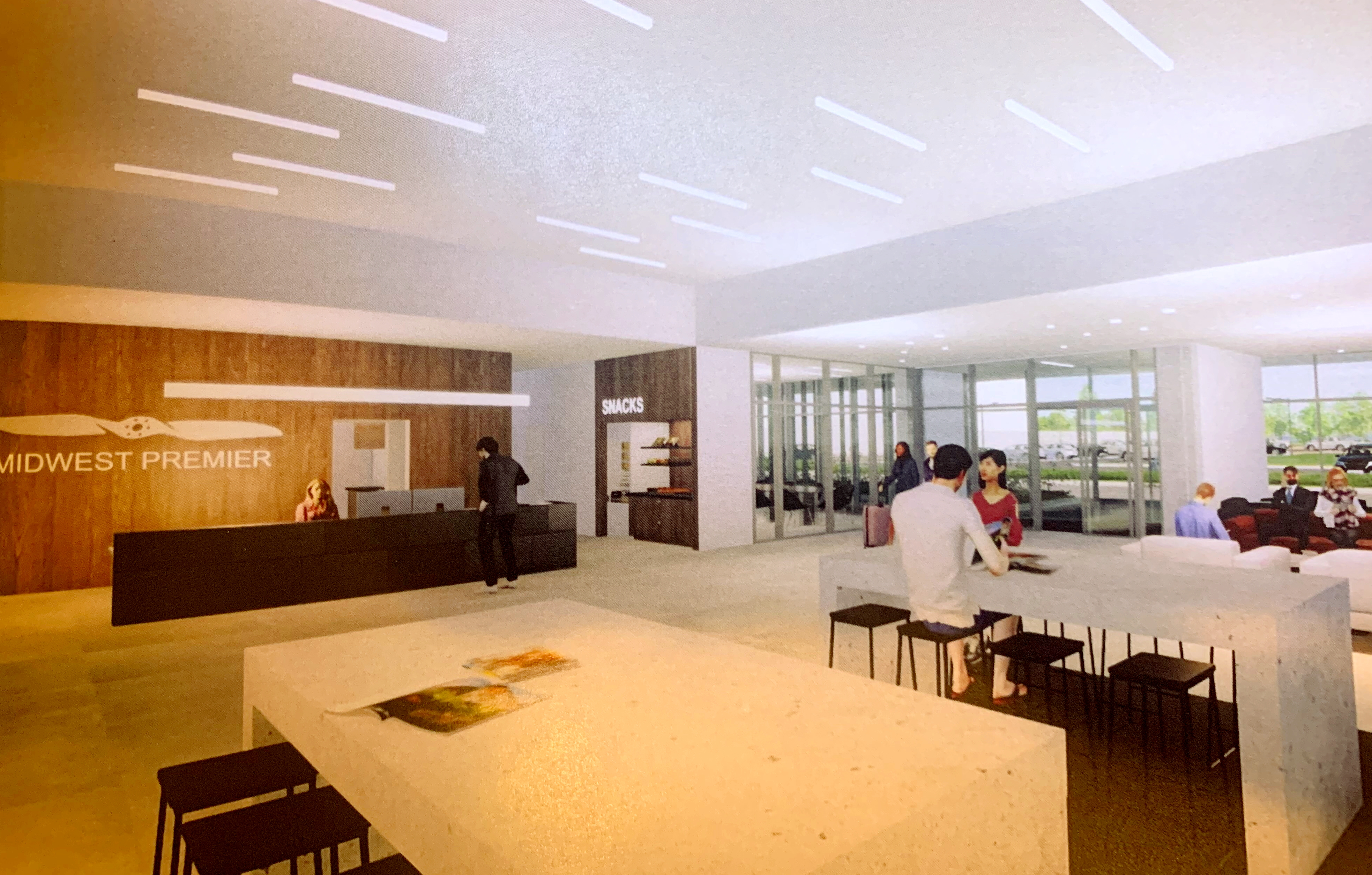
Project began in 2021
On Jan. 20, 2022, the airport board voted to proceed with the final design agreement.
Dave Schaumburg, assistant director of aviation at the Springfield-Branson National Airport, gave an in-depth overview of the project and explained its history.
In April 2021, the airport issued requests for proposals for firms to design a new building that would serve as the fixed base operation for the Springfield airport. The airport board interviewed four firms, and chose to negotiate with Dake Wells for the final design, with a cost of approximately $346,456.
The expanded building layout will have a new multipurpose room. The plan also calls for the FBO's bathrooms to be relocated.
“We have some issues with some plumbing from over 30 years ago that is just degrading,” Schaumburg said.
There will be some dedicated space for line service workers who walk onto the airport ramp to greet planes, fuel aircraft and move planes.
“There is also some landscaping, relocating a gate, and bringing some areas that are not currently inside the fence inside the fence, so we can have some additional equipment storage,” Schaumburg said.
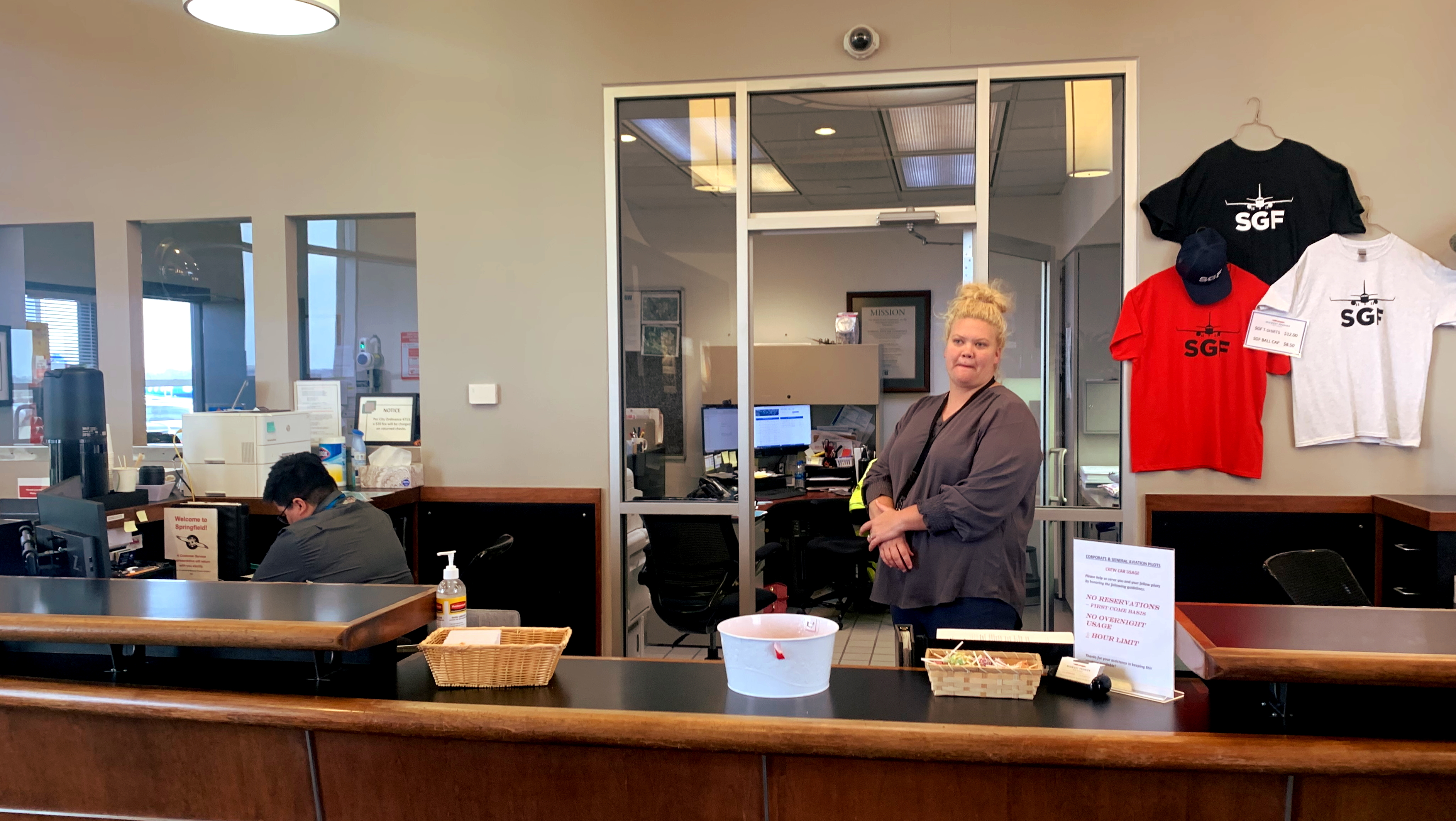
Seeking a contractor
The Springfield Airport Board is actively advertising for contractors to bid on the general aviation hangar expansion project.
CMAR is an abbreviation for “construction manager at risk,” a delivery method that puts an absolute maximum price into a building contract that the contractor is expected not to exceed. The maximum cost is based on the project’s specifications and the reasonably expected work it will take to build the building.
“Early contractor involvement,” or ECI as most government officials call it for short, puts the client — the Springfield-Branson Airport in this case — the building designer and the principal contractor together at an earlier stage than would typically happen in a competitive bidding process.
“It’s not new to the city. This approach is new to the airport. We’ve not done a project this way before, but what we’ve heard from folks is, ‘you ought to look at it because it’s a way to get the contractor at the design process much earlier,’” Weiler said.
Traditionally, a contractor gets involved in a public project after it has been designed and engineered. They bid on the project based on a detailed schematic and estimated expenses that the architects and engineers provide. Weiler said a traditional model can sometimes create issues, misunderstandings and inefficiencies with construction.
Springfield Public Schools has used the approach for a couple of projects, and Greene County is using it for the new jail, Weiler said. “The more we looked into it, we thought ‘It’s worth doing that.’”
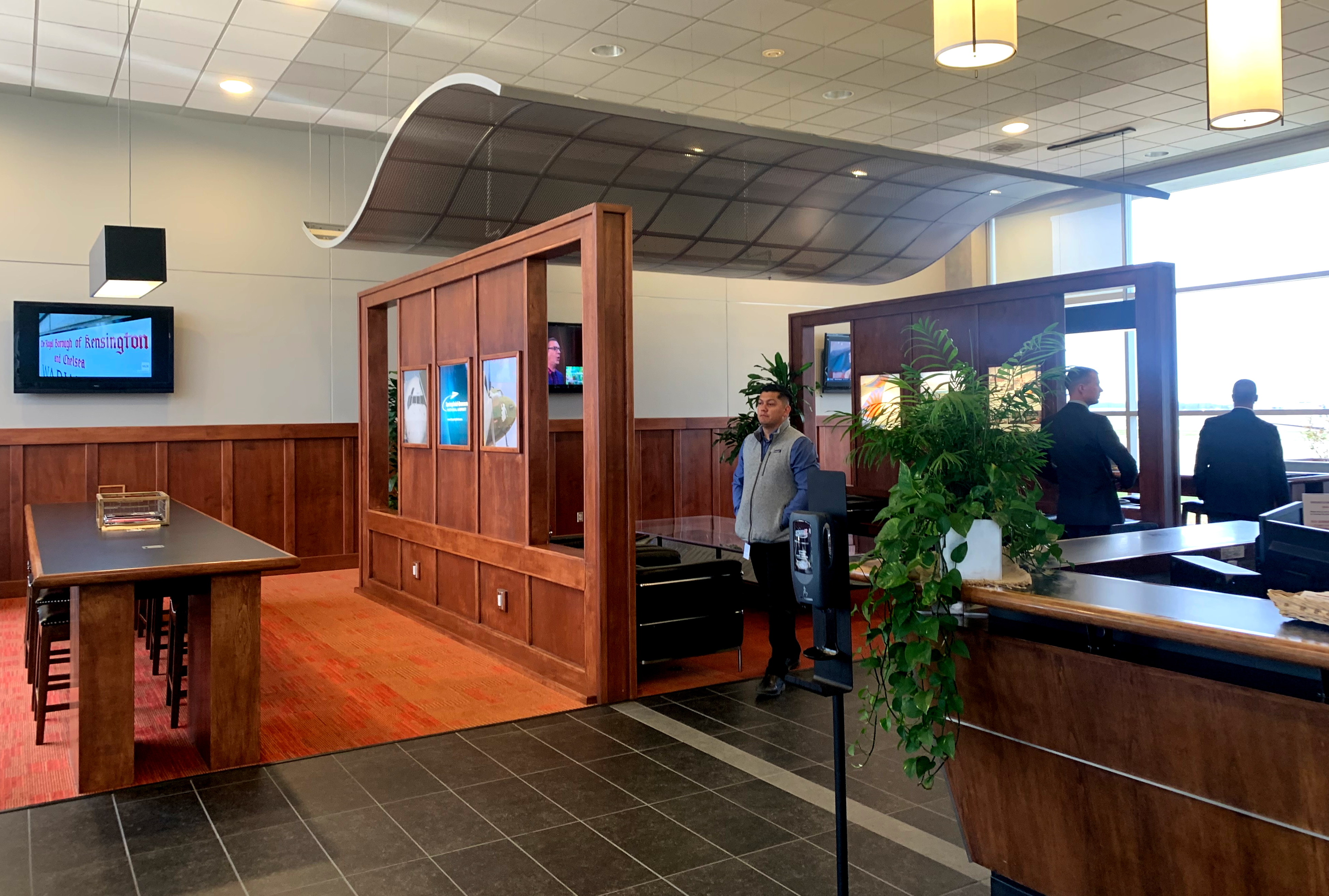
The process for soliciting the support of a principal contractor will take several weeks.
“We’re, like everybody, a little worried about the bidding environment, so we’re watching that closely,” Weiler said.
Schaumburg estimated that if construction started in the fall of 2022, it would proceed through the winter, spring and summer and wrap up in the late fall of 2023.
Joe Carmichael, Airport Board Chairman, spoke in support of using the construction manager at risk plan as opposed to a traditional design, bid and build process.
“It's a complicated project because it's a rehab and they're not just giving us a building design starting from scratch, which I think is always easier,” Carmichael said.
What is an airport FBO?
Some airports outsource their FBO operators to third-party vendors. The Springfield-Branson National Airport operates its own FBO.
“In those cases, a private company provided what is basically kind of the gas station for the airport,” Weiler said. “When I came to Springfield, though, that’s actually something that’s done by the airport. Those are my employees that do that.”
In total, about 100 of the 2,000 people who work at the Springfield airport on any given day are employees of the airport itself. The rest work for airport tenants and vendors who are somehow connected to the business of aviation.
Who should care?
- People who travel to and from the Springfield-Branson National Airport
- People involved in the Springfield economy, especially those invested in attracting, developing, growing and expanding businesses
- Major businesses that use the general aviation terminal, such as O’Reilly Auto Parts and Bass Pro Shops
- People interested in careers in aviation
Weiler said a municipally-run fixed base operation does not necessarily have the best reputation in the aviation industry. To spruce up the FBO operation in Springfield, the FBO was rebranded from FlySGF to Midwest Premier SGF, creating a feeling of separation from the airport as a whole.
“My goal is for someone to come here and have honestly no idea that this is a municipally run FBO,” Weiler said. “I would hope that we are professionally business-friendly and welcoming to our community.”
An airport FBO is meant to make money for the airport. The FBO in Springfield sells about 1.5 million gallons of aviation fuel per year, and offers services ranging from airplane wing de-icing to catering and concierge services for pilots and travelers.
In total, the Springfield-Branson National Airport sold about 9 million gallons of fuel in 2021, and most of that was jet fuel sold to airlines and to two major cargo companies, UPS and FedEx. General aviation accounted for about 16 percent of the airport’s total fuel sales.
Challenges ahead
There are three major challenges for the airport board and staff to proceed with expanding and remodeling the general aviation terminal. One is that the overall cost is not known until contractors submit bids and proposals. The second is the age of the building.
“We don't have great documents of the structure, it's over 30 years old,” Schaumburg said. “There are a lot of modifications that happen to the existing facility, and Dake Wells has built that in, so that they have enough effort available so they can assess that.”
It will be important for the contractor to have as much information as possible when the project begins.
“There is not one part of this building we’re not going to touch,” Weiler said.
The third challenge is that all of the expansion and remodeling will be done in and around an active, working airport terminal right next to a working runway.
“Probably the biggest challenge of this project will be we’re going to try to maintain the building throughout this process,” Weiler said. “There will be parts of the project where we don’t think that’s going to be possible.”
A decision on any closures or temporary buildings will be fleshed out as the design phase and the budgeting for the airport for the next fiscal year unfolds.
“There are a lot of things that we need to deal with as far as phasing, keeping the operation going. Do we totally shut it down and put in a temporary facility, which would very likely be some sort of modular building? Or do we phase it in? There are costs and time that are associated with that,” Schaumburg said.
While it could cause some frustrations for airport staffers in 2023, there is plenty of excitement surrounding the general aviation terminal renovation. Weiler compared it to the construction of the commercial airline terminal in 2011. The terminal offers the airport room to grow to accommodate more commercial aircraft as Springfield continues to grow and the airline industry adapts to a post-COVID world.
“Our new terminal opened up in ‘09, I came here in ‘11, and I’m not kidding, to this day, not a week goes by where I don’t hear some compliment about this terminal, the commercial airline terminal,” Weiler said. “We have arguably one of the nicer airline terminals for a community our size in the Midwest, and that was a bold step to do that.”
The Springfield Chamber of Commerce regularly sponsors trips for Springfield’s community and business leaders to visit other cities of similar size, and to look at projects and initiatives in those cities. Visits to places like Lexington, Kentucky, Boise, Idaho, and Chattanooga, Tennessee, led to ideas flying home to Springfield and landing at the airport.
“We wanted to go look at other facilities, so we actually looked at several facilities around the country, and also had a committee of local users,” Weiler said.
Weiler noted his staff gathered input from corporate pilots based in Springfield, who shared some thoughts based on what they have seen and experienced in other airports.
The Springfield Airport Board will maintain fiscal oversight and responsibility for the project. Any future involvement by the Springfield City Council will be through budgetary approval.

